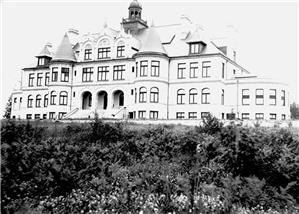This file contains the Seattle historian and photographer Paul Dorpat's Now & Then photographs and reflections on the University of Washington's Denny Hall, first UW building to be built (in 1894) on the Lake Washington campus in Seattle's University District.
Denny Hall
On a bright Fourth of July in 1894, a crowd of 1000, protected under sun bonnets, top hats, and bumbershoots, gathered at the University of Washington's new campus for the cornerstone laying of the site's first structure - Denny Hall.
The celebrants came by wagon, electric trolley, and special excursion train to listen to 13 speeches and a rendering of "The Star Spangled Banner" by Mrs. Fanni Ferguson. The Seattle Post-Intelligencer reported that Mrs. Ferguson sang "in such sweet tones and such warmth of feeling as surrounded the patriotic fervor fitting to the day."
Within a year, the four stories of Denny Hall rose from this cornerstone. Constructed from Enumclaw sandstone and pressed brick, with terra cotta details, it towers like a French chateau above the bushes in our historic photograph. The architect was Charles W. Saunders (1858-1935).
By September 1895, its 35 rooms were opened to a total student body of little more than 200. At first called the Administration Building, Denny Hall housed all six of the university's colleges in six laboratories, a library with 60 chairs, a museum, faculty rooms, professor's studies, a music room, a student lounge (although no doubt the best lounging was done on the front steps), and a 700-seat lecture hall named Denny.
This Denny was of course Arthur Armstrong Denny (1822-1899), commonly called both "father of the university" and "father of Seattle." He was a taciturn man, but he spoke during the July 1894 ceremony.
He began reluctantly: "Were I to consult my own feelings I certainly would say nothing on this occasion." Speaking "in deference to the wishes of the regents," he read a dry text detailing the early history of the Territorial University. He said not one word about how the territorial legislature had consistently faltered in its support of the university during its first 40 years. The patriotic and provincial elation of the occasion promised something better and, for the moment, dissipated old resentments.
It might have been a picnic that brought Carrie Coe with her camera and her family to this site (possibly in 1895) to admire the new building and photograph it. The Coe's were friends of education - Coe School on Queen Anne Hill is named after Carrie's husband Dr. Frantz Coe - and friends of the Denny family.
In 1910, the Administration Building was officially renamed Denny Hall. Only once was its existence threatened. In 1954, a regent complained that "Denny's belfry stuck up like a sore thumb above the modern campus" and suggested the building be razed. This was, happily, one modern urge that did not prevail.

